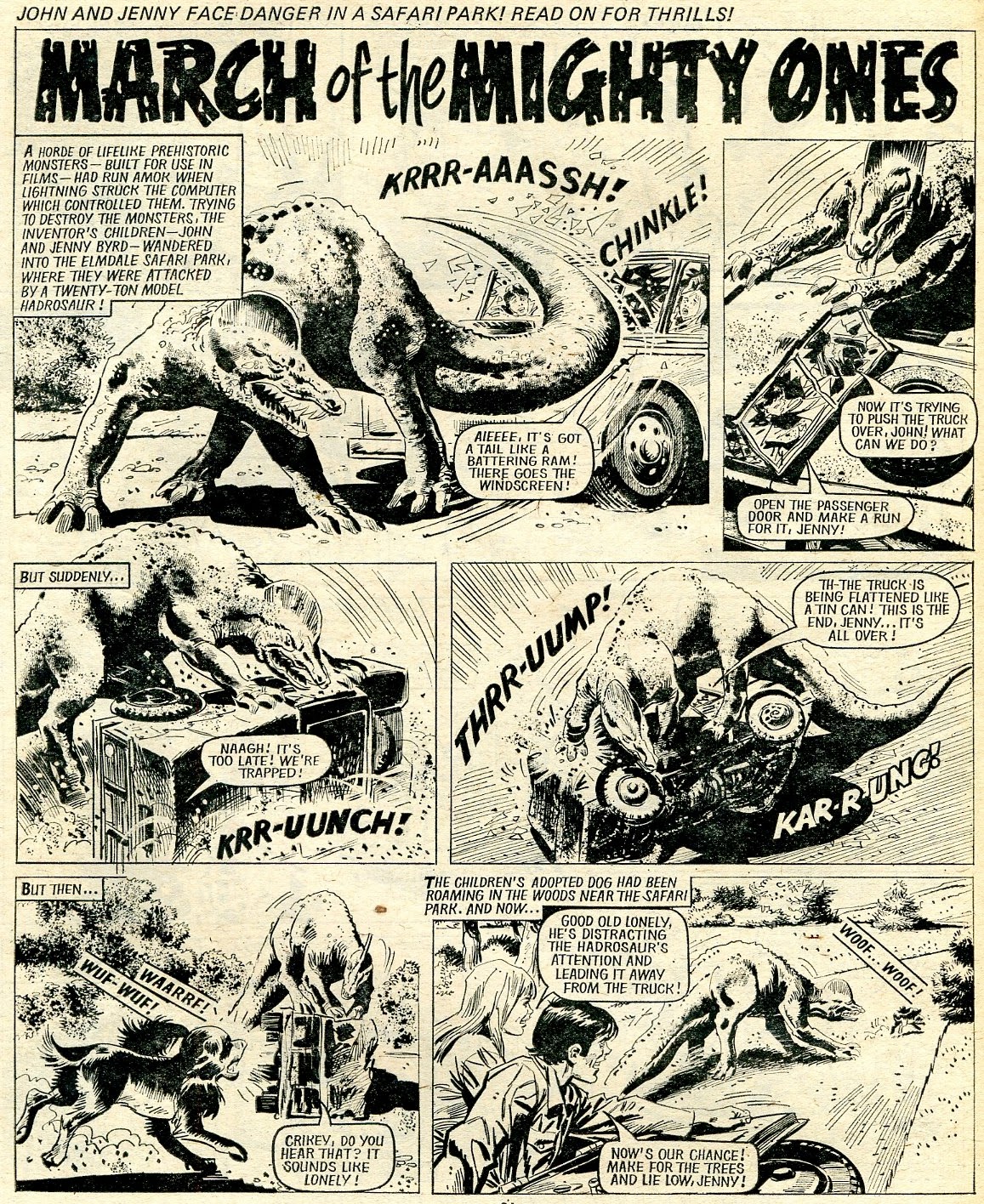This was
the general background for John’s and Jenny’s weekly dramatic encounters with
the various mechanical beasts. John had memorized lots of details about each
and every monster, so he always knew their exact weak spot or the place where
their vital parts were fitted. Young John Byrd had a good memory because
the number of beasts he and his sister Jenny tackled during the 73 episodes of
the story was quite impressive – I have counted 25 individual monsters and 8
groups between two and a few hundred ‘things’.


The vast majority were replicas of real dinosaurs and pre-historic
animals – such as Tyrannosaurus, Pterodactyl, Archaeotherium, Iguanodon,
Glyptodon, etc. etc.; a few were fantastic creatures – such as a giant ground sloth or a cross between
a camel and a pre-historic horse capable of firing electric power bolts from
its stubby trunk. There were some homo sapiens specimen as well – such as a pair of mechanical
prehistoric cave-men and even two professional criminals and bank robbers Jim and Joe; these two were different from the rest
because rather than being part of the horde of the monsters running amok, they
were crazy marauders looking to plunder the deserted town crawling with monster
machines.
In issues 54 to 56 John and Jenny got caught
in cross-fire as they accidentally found themselves in a private safari park
full of real feline predators and had to fight a twenty-ton Hydrosaur at the
same time:
The young
Byrds were quite inventive in their means of destruction: sometimes the two
monster-slayers used heavy construction machinery to wreck the fake monsters,
sometimes they burned or drowned them, and very often they smashed electronic
brain circuits and main control units of the predators or removed fuses from
their systems. This usually caused the mechanical beasts to go BA-THOOMPA! in
flames.


In a number of visually striking episodes fire only destroyed the outer
fabric covering and exposed the steel skeleton but did not stop the haywire
brute so finishing it off called for an extra effort of the Byrds.
Sometimes
the episodes were comical – in issue 10 an old man whom John and Jenny saved
from a nasty sabre-toothed tiger got so mad at a terrifying Megalosaurus for trampling
his property that he poked it with a pitchfork and short-circuit sent it into flames;
in another episode John tricked two aggressive robot cave-men into stuffing
themselves silly with canned herring and then ripped their main fuses out. Of
course, things weren’t always that easy; the brave monster-busters often faced
mortal danger and other drama such as separation, amnesia and even a hostage
situation. It’s nice how they managed to keep their mood up celebrating
important holidays:
…and simply
being normal kids:
In issue 43
the young Byrds met and adopted Lonely – a dog that became a full-fledged member of their monster-hunting team:
The scene
of the weekly episodes was set in different eerie settings often seen in horror
movies (deserted town, empty amusement park, old quarry, desolate movie
theatre, disused colliery shaft, toy factory warehouse, abandoned stately home
with a private maze, empty posh school, etc.). The writer of March of the Mighty Ones
also had a soft spot for vintage vehicles and machinery – whenever the kids needed
to drive somewhere, they could be trusted to pick a vintage car, and in No. 31 they
even borrowed a World War I tank from the local weapons museum and drove it against Cetiosaurus –
the biggest dinosaur of them all.

The last
cliff-hanger frame of the episode in issue 71 (Oh, no! I – I simply can’t believe it! Surely not… It can’t be! –
screams John upon seeing something we can’t see) kept readers in suspense for
two weeks because March of the Mighty Ones missed the penultimate issue of MFC
(No. 72 – the only issue without the story). The story ended with this whopping
4-page set in the last edition. The young monster hunters look as good as
doomed as they face a horde of the last remaining 5o of Dad’s fake monster army
led by a huge Tyrannosaurus:
As can be
seen from the last episodes, a change of the illustrator had taken place. The
main artist was Mike White who drew March of the Mighty Ones from the
first issue. Starting from the episode in MFC No. 63, Ron Turner took over and
continued drawing the feature till the very end.
The idea of
March
of the Mighty Ones lent itself perfectly to powerful visualisation and the excellent execution by two top-rate artists made it an attractive and
readable series. I find it a bit surprising it was not transferred to Buster and Monster Fun because I think
it had potential for a long and successful run.
















